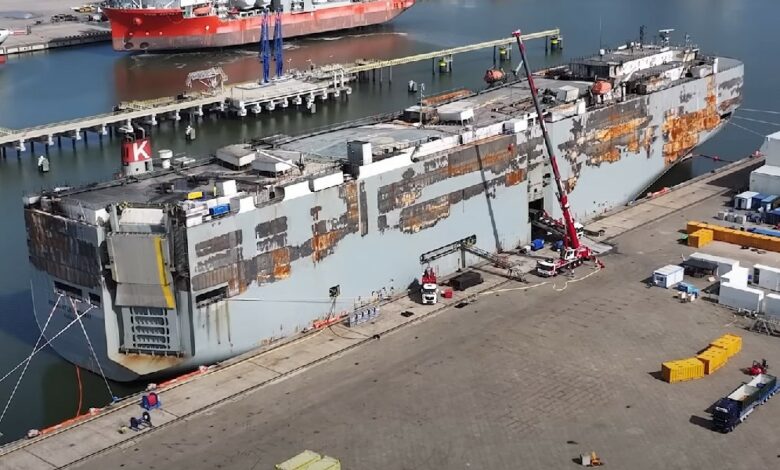IUMI publishes guidelines for safe sea transport of electric vehicles

In the wake of the Fremantle Highway car carrier fire, growing concerns within the shipping community arose regarding the possibility that this and other fires could be attributable to electric vehicles.
It must be said that the source of the blaze onboard the Fremantle Highway is still unknown and will remain such until an investigation is concluded. But there has been widespread speculation that an EV was to blame.
In damaged lithium-ion batteries, individual cells are prone to overheating, expelling flammable and toxic gases, and affecting surrounding cells as part of an explosive chain reaction called thermal runaway. Such batteries that catch fire can reach temperatures of more than 2,700 degrees Celsius.
The dangers of carrying lithium-ion batteries on ships were highlighted in an Allianz Global Corporate & Speciality report, which ranked fire and explosion as the number one cause of marine insurance losses by value from 2017 to 2021. The research, issued in November 2022, also revealed the growing threat of fires caused by lithium-ion batteries that are not stored, handled or transported correctly.
With that in mind, the International Union of Marine Insurance (IUMI) has researched these claims and published recommendations on the safe carriage of electric vehicles.
“Our paper draws on a body of scientific research that demonstrates that fires in battery EVs are not more dangerous than fires in conventional vehicles, nor are they more frequent. Although statistics continue to be gathered, they currently estimate that, in general, there are fewer fires from EVs compared with fires from conventional vehicles when driven over the same distance,” Lars Lange, IUMI secretary general, said.
Research also proves that there is only a minor difference between total energy released during an EV fire and one that is related to an internal combustion engine vehicle (ICEV). Once established, vehicle fires are around 80% fuelled by the car body and interior parts rather than the propulsion system.
However, the potential for thermal runaway – when the battery suffers an unstable chemical reaction – exists for EVs whereas it is not a consideration for ICEVs. Thermal runaway makes fires hard to extinguish, hence mitigation measures such as boundary cooling must be employed rapidly. Moreover, the risk of re-ignition is higher for an extended period of time.
In the paper, IUMI makes important distinctions between roros and pure car and truck carriers (PCTCs) noting that many roros will stow cars on open decks where air flow makes fire-fighting more challenging.
Ropax vessels, where passengers are also carried, present additional issues such as passengers wanting to charge onboard, and the possibility of cars being loaded that are older and potentially less safe. Conversely, PCTCs tend to carry vehicles tightly packed leaving little room for emergency access and facilitating the rapid spread of a fire.
Considering this, IUMI concluded that early fire detection and confirmation is critically important to reduce the time between detection and firefighting response to a minimum. Options, in addition to the conventional systems, could include thermal imaging cameras and AI-powered systems.
The Union added that drencher systems would be effective for fire-fighting onboard roro and ropax vessels both for EV and ICEV fires and should be installed alongside video monitoring systems. CO2 extinguishing systems, if applied quickly, are successful in fighting PCTC fires and their capacity should be doubled while the use of high-expansion foam fire extinguishing systems proved to be effective in preventing heat transfer from one vehicle to another.
Early detection, confirmation and a short response time are crucial to fight a fire successfully. On board PCTCs, fixed systems should always be applied before manual firefighting is employed, IUMI claimed.
Charging was another aspect looked at by the paper. One of the conclusions was that charging EVs onboard ropax vessels should be permitted subject to relevant risk assessments and control measures with safety mechanisms built into EVs activated during charging.
The IMO’s Sub-Committee on Ship Systems and Equipment will start work on the “evaluation of the adequacy of fire protection, detection and extinction arrangements in vehicle, special category, and ro-ro spaces in order to reduce the fire risk of ships carrying new energy vehicles” beginning in March 2024.
Calls to regulate batteries are growing, not just at sea, but on land as the British charity Electric Safety First recently called on the UK government to regulate e-bike batteries. They claimed that the stored energy of a fully charged e-bike battery is the equivalent of six hand grenades. Batteries on e-bikes are on average 140 times smaller than in an electric vehicle.

 car carrier
car carrier